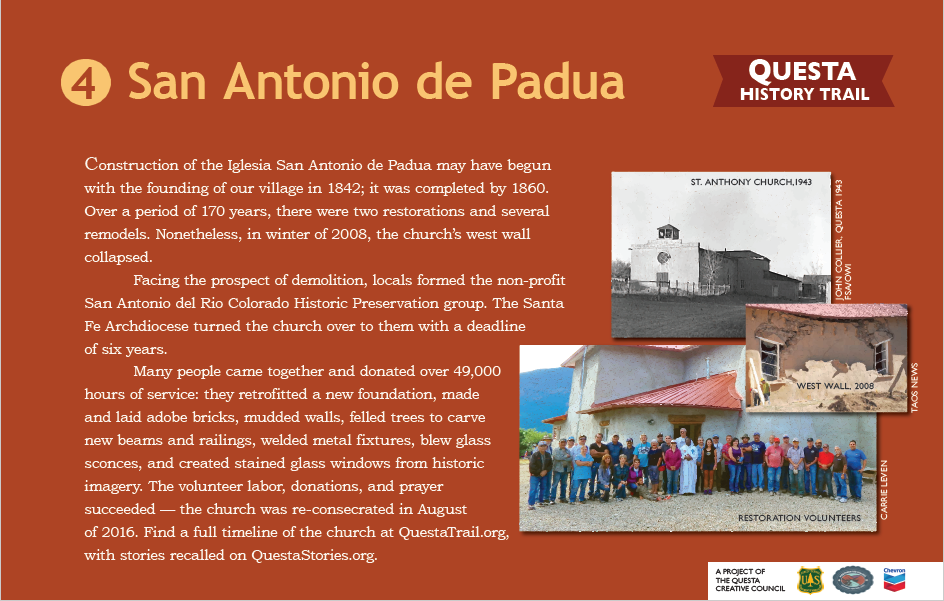Sign #4 Text:
Construction of the Iglesia San Antonio de Padua may have begun with the founding of our village in 1842; it was completed by 1860. Over a period of 170 years, there were two restorations and several remodels. Nonetheless, in winter of 2008, the church’s west wall collapsed.
Facing the prospect of demolition, locals formed the non-profit San Antonio del Rio Colorado Historic Preservation group. The Santa Fe Archdiocese turned the church over to them with a deadline of six years.
Many people came together and donated over 49,000 hours of service: they retrofitted a new foundation, made and laid adobe bricks, mudded walls, felled trees to carve new beams and railings, welded metal fixtures, blew glass sconces, and created stained glass windows from historic imagery. The volunteer labor, donations, and prayer succeeded — the church was re-consecrated in August of 2016. Find a full timeline of the church at QuestaTrail.org, with stories recalled on QuestaStories.org.
Archaeologists think this strategic hilltop and associated trail were used 5000 years ago until the late 1800s. This pueblito may date to 1150 AD. Accounts from the Spaniard Diego De Vargas mention an Apache farming village here in 1694, after the pueblito was abandoned. Other groups known to camp here or in the field below were Ute, Jicarilla Apache, and Kiowa.
According to oral history, the melted adobe ruins were cleared in the early 1930s to make way for the current VFW cemetery, “El Pueblito.” Decades of scavenging have left only a revered final resting place. Read more about this archaeology at QuestaTrail.org.
Labor of Love, Expression of Faith
Very little written history of Questa’s historic church exists, although there are many family memories and more recent experiences to explore.
Listen to interviews at QuestaStories.org; enjoy, learn, and contact us to add your own voice to this growing cache of important stories.
Today this once-damaged historic church is re-consecrated and again an important hub of the community. It is also a site of pilgrimage for the faithful, for local artists who paint the beautiful architecture beneath the soaring mountains, and for local craftspeople who take inspiration from the re-created fixtures and features.
Timeline of St. Anthony’s Church
Find full timeline of Questa history here
1836 – Canon del Rio Colorado land grant; first church built in Rio Colorado – Oratorio or Capilla at another location.
1840 – “El Oratorio” is built; a place of prayer and religious congregation, on the outskirts of Questa by the side of Cabresto Creek, just south of State Hwy 38, under a cluster of old cottonwood trees. This site is now abandoned.
1842 – Rio Colorado (now the village of Questa) officially founded, San Antonio Church probably begins construction.
1842 – First baptism records from Rio Colorado
Mid 1840s – late 1850s – construction of Rio Colorado church underway.
1855 – Ponderosa pine trees harvested on Flag Mountain for roof vigas on San Antonio church, mules used to skid logs down to Questa, while some vigas were carried by hand by the men.
1860 – Bishop Lamy visits Rio Colorado and notes “the beautiful new church on the north side of the plaza.”
1873 – New church reported as existing in 1873 as part of Rio Grande to Denver Railroad map, and railroad stations connected by stagecoach and freight wagon.
1880 – St Anthony’s church built (reported as existing), according to Library of Congress. (Maybe the new church was listed as part of a U.S. Census.)
1899 – Roof renovation of church, names found written on ceiling boards with 1899 date.
1942 – Msgr. Glenn Patrick Smith – first resident parish priest in Questa. He had a ham radio and speakers, and kept the village informed during WWII.
1943 – Single central bell tower at St. Anthony Church in old photo.
1950 – Two bell towers at St Anthony’s Church shown in old photo.
1972 – Major renovation of church, repair of west walls.
1999 – Renovation by Cornerstones historic preservation group, bell towers extended.
2000 – Limestone whitewash over exterior adobe bricks.
200? – Adobe color plaster over lime stone? Must have occurred sometime then?
2008 – West wall of St. Anthony’s church collapses.
Repairs to the adobe walls undertaken since the 1970s had neither been lasting nor successful, resulting in continued degradation. An effort in the late 1990s to preserve the original east wall left the old wall intact but unstable, hidden and crumbling behind a facade.
2009-10 – Many, but not all parishioners, community members, and Village of Questa want to save the church. Priest and Diocese of Santa Fe want to demolish the old and build anew.
2011 – San Antonio church declared a historic building suitable for preservation.
2011 – Archdiocese relinquishes control of St. Anthony’s Church to San Antonio del Rio Colorado Preservation for six years to complete restoration.
2012 – West wall completed.
2013 – East wall completed.
2014 – Back/north wall completed, heating system and subfloor.
2015 – Front portal finished and exterior brown coat, electric system in place.
2016 – Plaster coat and paint inside, new floor, sound system, altar screen, retablos, and stained glass windows installed.
2016 – August 8, 2016, dedication mass at completed church.
2017 – Final landscaping and color coat.


